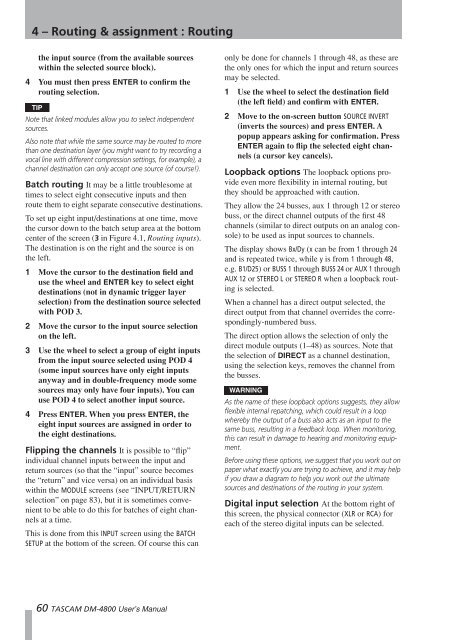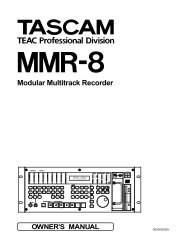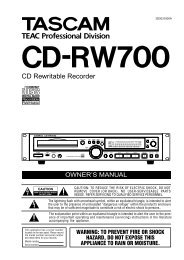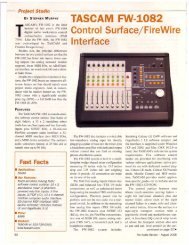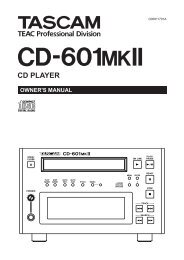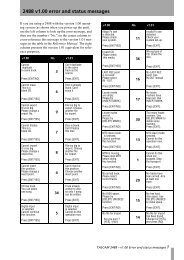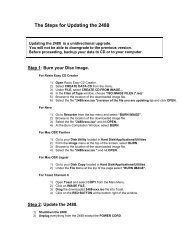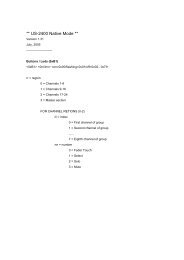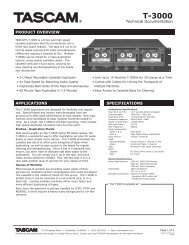DM-4800 OWNER'S MANUAL - zZounds.com - Tascam
DM-4800 OWNER'S MANUAL - zZounds.com - Tascam
DM-4800 OWNER'S MANUAL - zZounds.com - Tascam
Create successful ePaper yourself
Turn your PDF publications into a flip-book with our unique Google optimized e-Paper software.
4 – Routing & assignment : Routing<br />
the input source (from the available sources<br />
within the selected source block).<br />
4 You must then press ENTER to confirm the<br />
routing selection.<br />
TIP<br />
Note that linked modules allow you to select independent<br />
sources.<br />
Also note that while the same source may be routed to more<br />
than one destination layer (you might want to try recording a<br />
vocal line with different <strong>com</strong>pression settings, for example), a<br />
channel destination can only accept one source (of course!).<br />
Batch routing It may be a little troublesome at<br />
times to select eight consecutive inputs and then<br />
route them to eight separate consecutive destinations.<br />
To set up eight input/destinations at one time, move<br />
the cursor down to the batch setup area at the bottom<br />
center of the screen (3 in Figure 4.1, Routing inputs).<br />
The destination is on the right and the source is on<br />
the left.<br />
1 Move the cursor to the destination field and<br />
use the wheel and ENTER key to select eight<br />
destinations (not in dynamic trigger layer<br />
selection) from the destination source selected<br />
with POD 3.<br />
2 Move the cursor to the input source selection<br />
on the left.<br />
3 Use the wheel to select a group of eight inputs<br />
from the input source selected using POD 4<br />
(some input sources have only eight inputs<br />
anyway and in double-frequency mode some<br />
sources may only have four inputs). You can<br />
use POD 4 to select another input source.<br />
4 Press ENTER. When you press ENTER, the<br />
eight input sources are assigned in order to<br />
the eight destinations.<br />
Flipping the channels It is possible to “flip”<br />
individual channel inputs between the input and<br />
return sources (so that the “input” source be<strong>com</strong>es<br />
the “return” and vice versa) on an individual basis<br />
within the MODULE screens (see “INPUT/RETURN<br />
selection” on page 83), but it is sometimes convenient<br />
to be able to do this for batches of eight channels<br />
at a time.<br />
This is done from this INPUT screen using the BATCH<br />
SETUP at the bottom of the screen. Of course this can<br />
60 TASCAM <strong>DM</strong>-<strong>4800</strong> User’s Manual<br />
only be done for channels 1 through 48, as these are<br />
the only ones for which the input and return sources<br />
may be selected.<br />
1 Use the wheel to select the destination field<br />
(the left field) and confirm with ENTER.<br />
2 Move to the on-screen button SOURCE INVERT<br />
(inverts the sources) and press ENTER. A<br />
popup appears asking for confirmation. Press<br />
ENTER again to flip the selected eight channels<br />
(a cursor key cancels).<br />
Loopback options The loopback options provide<br />
even more flexibility in internal routing, but<br />
they should be approached with caution.<br />
They allow the 24 busses, aux 1 through 12 or stereo<br />
buss, or the direct channel outputs of the first 48<br />
channels (similar to direct outputs on an analog console)<br />
to be used as input sources to channels.<br />
The display shows Bx/Dy (x can be from 1 through 24<br />
and is repeated twice, while y is from 1 through 48,<br />
e.g. B1/D25) or BUSS 1 through BUSS 24 or AUX 1 through<br />
AUX 12 or STEREO L or STEREO R when a loopback routing<br />
is selected.<br />
When a channel has a direct output selected, the<br />
direct output from that channel overrides the correspondingly-numbered<br />
buss.<br />
The direct option allows the selection of only the<br />
direct module outputs (1–48) as sources. Note that<br />
the selection of DIRECT as a channel destination,<br />
using the selection keys, removes the channel from<br />
the busses.<br />
WARNING<br />
As the name of these loopback options suggests, they allow<br />
flexible internal repatching, which could result in a loop<br />
whereby the output of a buss also acts as an input to the<br />
same buss, resulting in a feedback loop. When monitoring,<br />
this can result in damage to hearing and monitoring equipment.<br />
Before using these options, we suggest that you work out on<br />
paper what exactly you are trying to achieve, and it may help<br />
if you draw a diagram to help you work out the ultimate<br />
sources and destinations of the routing in your system.<br />
Digital input selection At the bottom right of<br />
this screen, the physical connector (XLR or RCA) for<br />
each of the stereo digital inputs can be selected.


